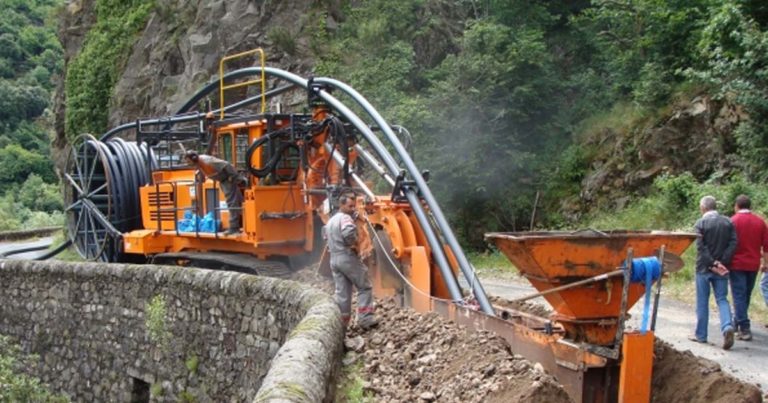Polyethylene pipe is the only type that can be laid in a variety of different ways, from conventional cut and cover to very fast methods made possible by its availability in very long lengths.
Conventional laying method
Open trench laying, currently the most widely-used technique.
The natural flexibility of polyethylene pipe enables it to do away with elbows at bend radii that would be too acute for polyethylene pipes. This property allows it to get around underground obstacles and easily cross other networks.
The excavation width must be determined to allow the conduit to be paid out and the backfill to be compacted. The following allowances must be made on either side of the conduit: outer diameter (DN) – min conduit width:
• 20 to 160: 100 mm
• 180 to 600: 300 mm (see Section 71)
• > to 600: 400 mm (see Section 71)
The maximum length the trench can remain open is specified by the principal contractor.
Unless otherwise stated, the trench depth is usually such that the upper generatrix of the water supply pipeline is buried deep enough to protect the pipe against frost. As a general rule, the minimum recommended depth is 0.8 m to the upper generatrix of water supply pipelines, and 0.4 m for connections on private land without traffic.
The trench bed is excavated with the prescribed slope and compacted where necessary, making a bed for each pipe to rest on over its entire length. Where applicable, recesses are dug to accommodate pipe unions.
Water seepage is drained to keep the groundwater level below the bottom of the excavation for the duration of the work. If rock banks or masonry are encountered, the excavation depth is increased by at least 10 cm, then lined with sand up to the original set level.
Care must be taken during installation. The pipe bed must be lined with a layer of at least 10 cm of fill material consisting of river sand with a grain size of between 0.1 and 5 mm (or 5 and 15 mm in the presence of groundwater).
PE pipes that have been joined together by welding can generally support longitudinal forces and need neither stops nor anchors on bends or branching pipes.
Best practice is to keep the end caps on until the connection is made:
- to prevent foreign bodies and animals from intruding
- to keep the pipeline clean and sanitary
- to eliminate thermal contraction due to air currents during welding
When laying pipes supplied in coils, the pipe should be uncoiled rather than pulled to prevent twisting.
Laying method using a trenching machine
Because of its availability in great lengths in coils and on drums, polyethylene pipe is especially well-suited to being laid with a trenching machine, the fastest method of all, allowing over 1000 m of DN160 pipe to be laid in a single day thanks to the 480 m drums it comes on.
There are two types of trenching machine: wheel trenchers and chain trenchers.
Wheel trenchers are generally only used on difficult terrain such as might be encountered when laying conduit along a motorway where the road surface would need to be ‘cut’. The trencher digs a narrow trench and a system at the back of the machine lays the pipes and puts down the sand and warning netting.
Chain trenchers differ from wheel trenchers in that the sprocket is replaced by a bucket chain enabling the trenching machine to dig wider, deeper trenches. A conveyor belt system removes the excavated material so that it can be replaced with fill material of the appropriate grain size.
Alternative laying method
The development of polyethylene materials has led to further network safety improvements when an alternative laying method is used – trenchless installation or installation without sand embedding. It is the advent of PE100RC (Prolinear) type resins that has made the new laying methods possible, whereby it is no longer the pipeline that dictates the choice of embedding material, but the level of compaction required for the trench.
The trenchless installation technique that is most prevalent at the moment is directional drilling, followed by destructive replacement, sleeved drilling, sinking, swagelining and roll-down.
The reliability and strength of polyethylene pipes and the professionalism of the pipe layers, for whom this method of installation holds no mysteries, allows the service life of polyethylene pipelines to be estimated at over 100 years!
MPS
